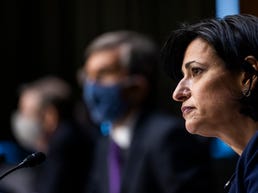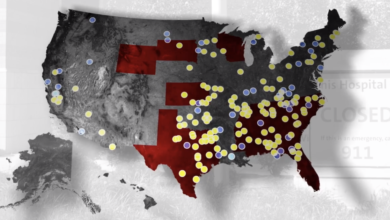
The Centers for Disease Control and Prevention announced new masking guidelines Thursday that carry welcome words: Fully vaccinated Americans, for the most part, no longer need to wear masks indoors.
The agency also said fully vaccinated people don’t have to wear masks outdoors, even in crowded spaces.
There are still some exceptions. But the announcement represents a quantum shift in recommendations and a major loosening of the mask restrictions that Americans have had to live with since COVID-19 became a major part of U.S. life 15 months ago.
"Anyone who is fully vaccinated can participate in indoor and outdoor activities, large or small, without wearing a mask or physical distancing,'' CDC Director Dr. Rochelle Walensky said during a White House briefing. "If you are fully vaccinated, you can start doing the things that you had stopped doing because of the pandemic.''
Health experts say the new CDC guidelines may encourage more people to get vaccinated by enticing them with tangible benefits, but it may also add to the confusion of mask etiquette in the United States.
Here are some questions that remain unanswered:
What places do I still need to wear a mask?
CDC guidelines say fully vaccinated people must still wear a mask in health care settings, transportation hubs such as airports and stations, and public transportation. That includes planes, buses and trains traveling into, within or outside of the U.S. as part of a federal mask mandate that was extended to Sept. 13.
The agency also said fully vaccinated people must wear a mask or socially distance in places required by federal, state, local, tribal, or territorial laws, rules, and regulations, including local business and workplace guidance.
It means fully vaccinated people may still need to wear a mask depending on where they live and where they go. Some business owners may follow CDC guidelines, but others may be more reluctant to lift their own rules on masking.
How is this going to be enforced?
If schools, offices, or local businesses plan to implement CDC guidelines and allow fully vaccinated people to remove their masks indoors, how will they do that?
It’s impossible to know for sure if someone is fully vaccinated or unvaccinated without asking to look at their vaccination card.
“We’re creating a situation where private companies or individuals are responsible for their business and find(ing) out if people are vaccinated – if they’re even going to be enforcing that,” said Rachael Piltch-Loeb, associate research scientist at New York University School of Global Public Health and a preparedness fellow at Harvard T.H. Chan School of Public Health.
Masking is a politically charged subject, she said, and inquiring about vaccination status could fuel debate in an already divided country.
Why lift the mask mandate now?
The agency said its decision to update its indoor masking guidelines for fully vaccinated people stems from the steady decline of coronavirus cases and hospitalizations, and the promising data that demonstrates the COVID-19 vaccines’ effectiveness in real-world studies.
The CDC reported about 34,200 new cases Wednesday, a 23% decrease since Sunday. The seven-day average of hospital admissions also decreased about 12% from the previous seven-day average.
“And every day, with the cases continuing to fall, we remain encouraged by these positive trends,” Walensky said.
However, health experts say coronavirus cases are still spiking in some parts of the country as vaccination rates have slowed and only about 35% of the total U.S. population is fully vaccinated.
The CDC director also cited two real-world studies that looked at 9,000 health care workers in United States and one real-world study from Israel suggesting fully vaccinated people are not likely to carry and spread the virus.
But the CDC says on its website scientists are still learning how effective the vaccines are against the virus variants, how well the vaccines protect people with weakened immune systems and how long COVID-19 vaccines can protect people.
“It seems like a lot of change all at once,” Piltch-Loeb said. “We don’t know what vaccine effectiveness will look like if we drop recommendations of mask wearing and social distancing… To ignore a sense of caution indoors is too big of a jump at this point in time.”
Can the CDC bring back masking guidelines for fully vaccinated people?
The CDC said it’s possible masking guidelines may return for fully vaccinated people in the future if vaccination rates decrease and coronavirus transmission increases.
“This past year has shown us that this virus can be unpredictable,” Walensky said. “So, if things get worse, there’s always a chance we may need to make changes in these recommendations.”
However, it’s unclear if the agency is truly willing to do this and take another hit to their reputation, Piltch-Loeb said.
Dr. Jay Wolfson, a public health expert at the University of South Florida, said the shift comes after the CDC had lost a great “a great deal of credibility” in the public's perception throughout the pandemic, in part because the agency’s guidance was often overly cautious. Often the agency’s guidelines on behaviors such as hand-washing and mask wearing lagged behind the “pragmatic realities” of the pandemic, Wolfson said.
“The CDC has had a blow to their credibility over the last year,” Piltch-Loeb said. “There’s a lot to unpack there in timing and decision-making and rationale from what the CDC is doing, but they’re stuck in balancing the tension between individual needs and population norms.”
Follow Adrianna Rodriguez on Twitter: @AdriannaUSAT.
Health and patient safety coverage at USA TODAY is made possible in part by a grant from the Masimo Foundation for Ethics, Innovation and Competition in Healthcare. The Masimo Foundation does not provide editorial input.
Source link








